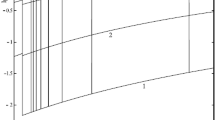Abstract
The structure of optically thick mass-losing envelopes of white dwarfs are studied in relation to nova outbursts. A sequence of steady mass-loss solutions is constructed for a nova outburst from the maximum photospheric radius to the disappearance. Much of mass of the envelope will be blown out.
Similar content being viewed by others
References
Kato, M.: 1983a,Publ. Astron. Soc. Japan 35, 33.
Kato, M.: 1983b,Publ. Astron. Soc. Japan 35, in press.
Nariai, K. and Nomoto, K.: 1979, Proceedings of Fourth Annual Workshop onDwarf Novae and Other Cataclysmic Variables, Rochester, p. 525.
Nariai, K., Nomoto, K., and Sugimoto, D.: 1980,Publ. Astron. Soc. Japan 32, 473.
Ruggles, C. L. N. and Bath, G. T.: 1979,Astron. Astrophys. 80, 97.
Truran, J. W.: 1981, in D. Wilkinson (ed.),Progress in Particle and Nuclear Physics, Vol. 6, Pergamon Press, Oxford.
Author information
Authors and Affiliations
Rights and permissions
About this article
Cite this article
Kato, M. Steady mass loss associated with nova outbursts. Astrophys Space Sci 99, 295–298 (1984). https://doi.org/10.1007/BF00650253
Received:
Issue Date:
DOI: https://doi.org/10.1007/BF00650253




